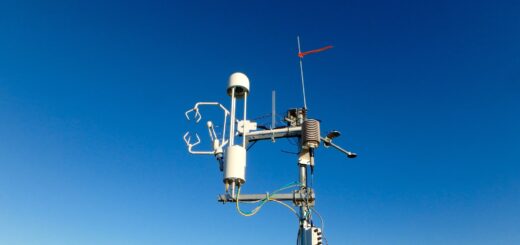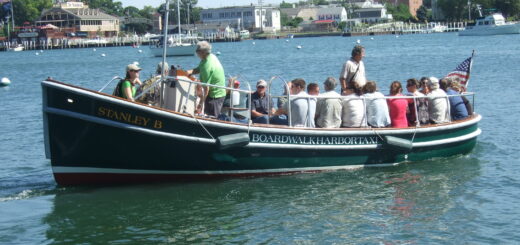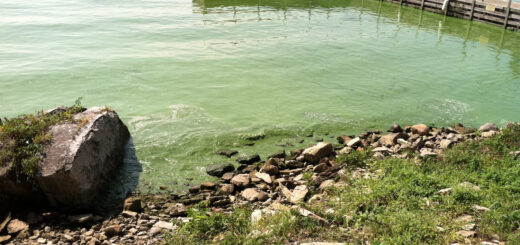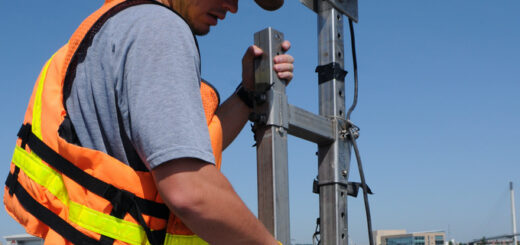Acidification affects both marine and freshwater ecosystems, leading to variances in microorganism communities as well as impacting water quality overall. Ocean acidification is caused by CO2 in the atmosphere dissolving in seawater, producing carbonic acid, thus lowering surface ocean pH.1 In freshwater environments, acidification occurs more commonly as a result of acidic inputs—while some still absorb CO2 like oceans, this phenomenon is generally deemed less influential in freshwater environments.2
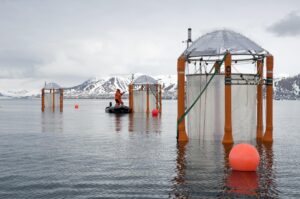
Scientists sampling mesocosms during an outdoor experiment investigating the reactions of marine organisms to ocean acidification at Kongsfjord, Ny-Alesund, Svalbard (Credit: Maike Nicolai via Wikimedia Commons CC BY-SA 4.0)
The concern surrounding acidification is a result of how the process impacts local microorganism communities and other members of the ecosystem. Due to the prevalence of plastic pollution, many microscopic organisms in the ocean live on plastic waste. A 2023 study published in Limnology and Oceanography Letters sought to examine how ocean acidification affects communities of prokaryotes and eukaryotes growing and living on plastic in subtropical eutrophic waters.
The study examined multiple acidification scenarios in order to estimate how future scenarios of increased CO2 emissions will impact these communities and the plastic they reside on. First used by Zettler et al. (2013), this “plastisphere”, or an ecosystem of microbes living on floating plastic with communities that are distinct from the surrounding water, is a unique and relatively newly defined phenomenon.3
In the age of plastic, the prevalence of inorganic materials in the world’s waters has led some species to make homes in these seemingly strange places. Larger aquatic species are known to use disposed of containers as shelter, similar to behaviors shown in microbial communities that reside in bottles or other plastic objects.
Methods
The study took place in the subtropical coastal seawater of Wuyuan Bay in the East China Sea. Wuyan Bay was chosen due to the region’s high rates of ocean acidification. The process is more severe in Wuyuan due to nutrient inputs that cause eutrophication and stimulate microbial degradation of organic matter, lowering the pH.
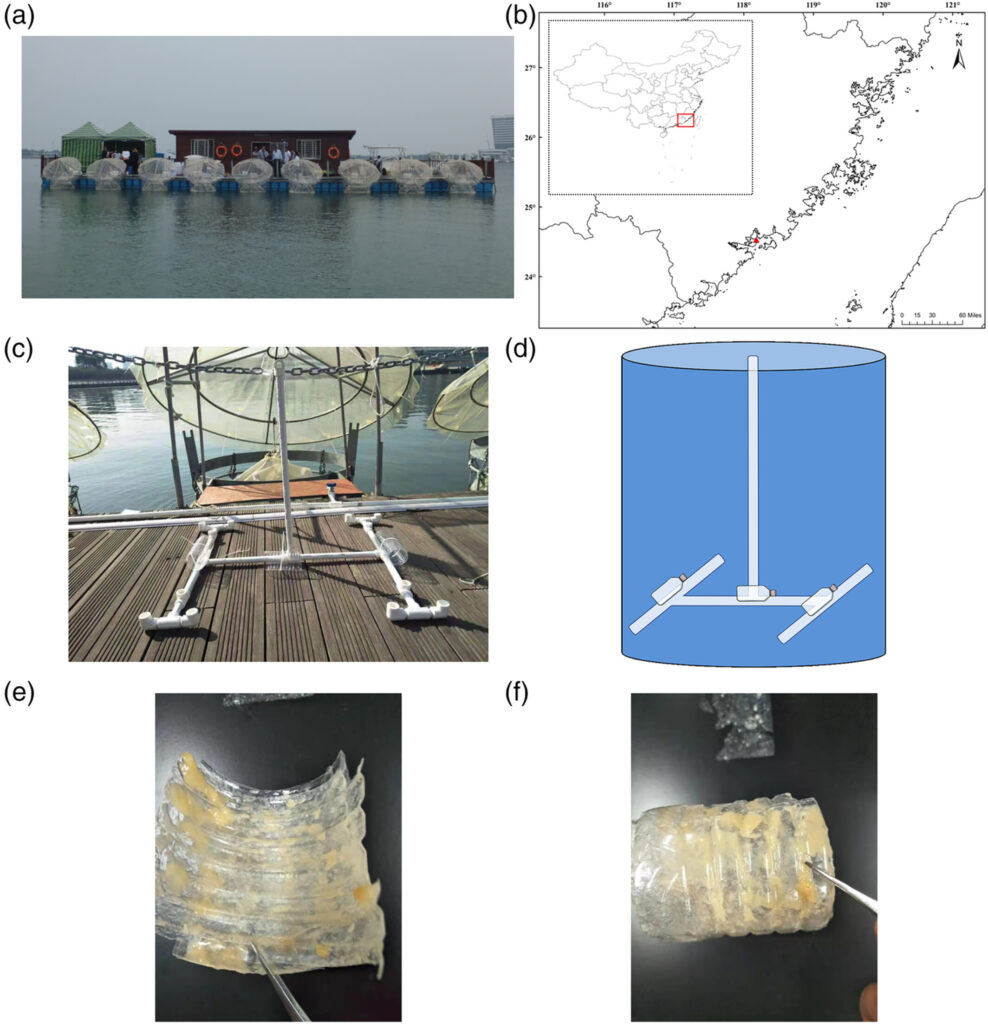
Ocean acidification mesocosms in Wuyuan Bay, Xiamen, China (a). Location of mesocosms (b). Deployment of PET drinking bottles in the mesocosms (c,d). Biofilm on a drinking bottle after the 32‐d experiment (Credit: Zhang et al., 2023)
Nine cylindrical transparent thermoplastic polyurethane mesocosm bags were used to create the artificial habitat. Bags 1, 3, 5, 7 and 9 were acidified with CO2-saturated seawater in order to simulate a scenario of high emissions corresponding to the year 2100. Conversely, bags 2, 4, 6 and 8 were the control group. The experimental group’s seawater measured 1000μatm CO2, whereas the control group was exposed to ambient water reflecting the bay’s current acidification levels.
Three plastic bottles per mesocosm were attached inside each habitat. After 32 days, two plastic bottles were randomly selected from each bag and examined. The bottles were scratched for DNA extraction that was then amplified and sequenced. The presence and representation of microorganism communities were identified and determined through 18S gene sequencing.
Results
Results of the study indicate that elevated CO2 significantly influences the taxa of microorganisms. The average in-situ pH over the duration of the experiment was 7.78, which is representative of eutrophic coastal seawater in the region.
In 32 days, 25 prokaryotic Phyla and 26 eukaryotic Phyla colonized the plastic bottles. In the high carbon emission scenario, the prokaryotic community was more affected than the eukaryotic community. Elevated CO2 also caused an increase in diatom abundances on plastic surfaces.
Secondary producers with lower abundance were impacted by increased CO2 emissions, indicating that organisms in higher trophic levels are sensitive to high CO2. The study also found that under increased CO2, there was also a growth in the relative abundance of bacterial taxa involved in nitrogen and nitrate respiration, as well as ureolysis. All of which may indicate that continuous ocean acidification may promote denitrification and organic nitrogen utilization.
Further research surrounding the influence of CO2 on the plastisphere need to be conducted in order to better understand how various ecosystems and organisms will be impacted by increased emissions in the future.
Sources
- Zhang, X., Zhang, P., Deng, Z., Huang, R., Zhang, D., Tian, Y., Wang, N., Li, H., Wang, X., Jiang, X., Sun, J., Fu, Q., Yi, X., Qu, L., Zhou, C., Rao, Y., Zeng, X., Hall-Spencer, J.M., Gao, G., Gao, K. and Lin, X. (2023), Ocean acidification has a strong effect on communities living on plastic in mesocosms. Limnol. Oceanogr. Lett. https://doi.org/10.1002/lol2.10329
-
Muniz, I. (1990). Freshwater acidification: Its effects on species and communities of freshwater microbes, plants and animals. Proceedings of the Royal Society of Edinburgh, Section B: Biological Sciences, 97, 227-254. doi:10.1017/S0269727000005364
- Zettler ER, Mincer TJ, Amaral-Zettler LA. Life in the “plastisphere”: microbial communities on plastic marine debris. Environ Sci Technol. 2013 Jul 2;47(13):7137-46. doi: 10.1021/es401288x. Epub 2013 Jun 19. PMID: 23745679.




